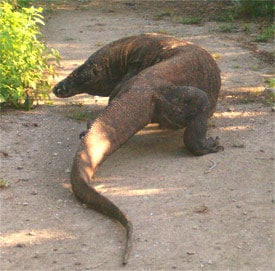 Komodo National Park is located between the islands of Sumbawa and Flores in the Lesser Sunda Islands, at a distance of 200 nautical miles to the east of Bali. It has a total land area of 75,000 hectares and encompasses a number of islands, the largest of which are Komodo (34,000 hectares), Rinca (20,000 hectares), Padar, Nusa Kode, Motang, numerous smaller islands, and the Wae Wuul sanctuary on Flores. A total of 112,500 hectares of the surrounding waters are also under the jurisdiction of the park rangers.
Komodo National Park is located between the islands of Sumbawa and Flores in the Lesser Sunda Islands, at a distance of 200 nautical miles to the east of Bali. It has a total land area of 75,000 hectares and encompasses a number of islands, the largest of which are Komodo (34,000 hectares), Rinca (20,000 hectares), Padar, Nusa Kode, Motang, numerous smaller islands, and the Wae Wuul sanctuary on Flores. A total of 112,500 hectares of the surrounding waters are also under the jurisdiction of the park rangers.
Komodo National Park has widely known with the home of the giant lizard Komodo Dragon - which has just declare to be one of the latest heritage of the world. Explore the under water live and its ecosystems which has well known as the best diving site in the world. From beautiful coral, reefs, thousands sort of fishes to the crystal water and beautiful beach are await to visit. Komodo dragons live in one of the driest area in Indonesia, where there are few permanent water sources. The mix vegetation of Komodo National Park provides habitat and shade for different animals of the park. There are 254 plants species from Asian and Australian origin. Komodo dragons are carnivores and do not eat any of the vegetation. However, the main prey of Komodo dragon, such as deer and will boar, feed on various leaves, fruit, flowers, roots and grasses found in the park.
Most of the Park is dry, rugged and hilly, a combination of ancient volcanic eruptions and more recent tectonic uplift of sedimentary seabeds. The irregular coastline is indented with rocky headlands and sandy bays, many framed by soaring volcanic cliffs.
Komodo island is 35km long and 15km wide, and is mountainous on a north to south axis, with an average altitude of 500-600m. The highest peak is Satalibo (735m) in the north. Most of the island is lontar palm savannah with remnates of rainforest and bamboo forest at higher elevations. On Rinca the land rises gradually from the north coast to a plateau that ends at Mount Dora (667m) in the south. The rugged south coast is very sheer as a result of volcanic activity in the distant past, as evidenced by the crater bay in which Nusa Kode nestles.
Labels
- Aceh (1)
- Bali (2)
- Batak (8)
- Hotel (1)
- Indonesia food (1)
- Jambi (2)
- Karo Song (1)
- Komodo (1)
- Medan (6)
- National Park (4)
- Natural Object (4)
- Nias Island (1)
- North Sumatra (48)
- Obama (1)
- Riau Island (1)
- South Sumatra (1)
- Spiritual tourism (1)
- Tanah Karo (30)
- West Sumatra (2)
Komodo National Park
Label: Komodo, National Park
Subscribe to:
Post Comments (Atom)




0 coment:
Post a Comment